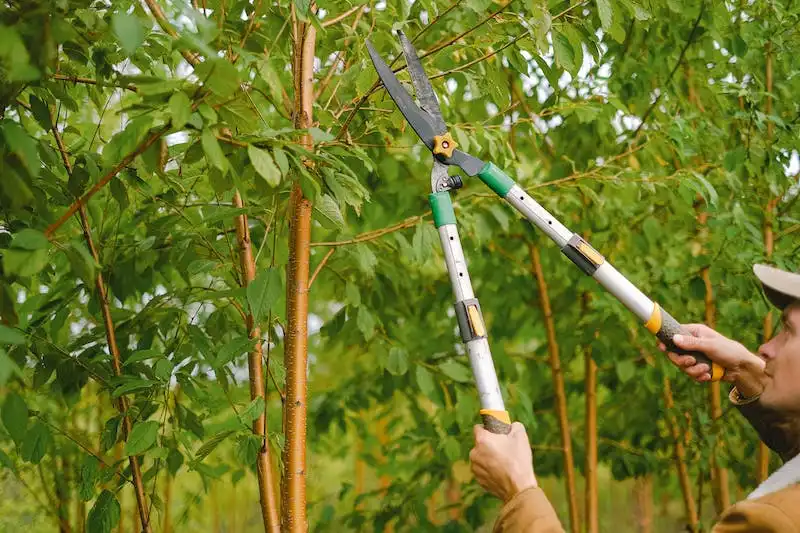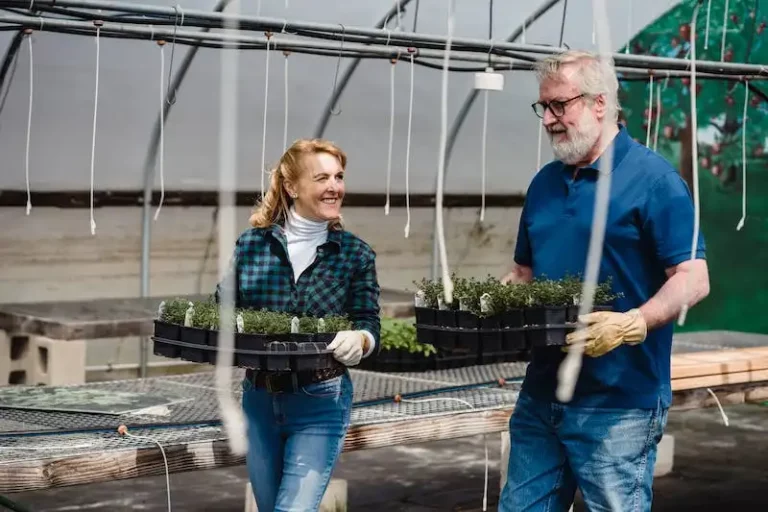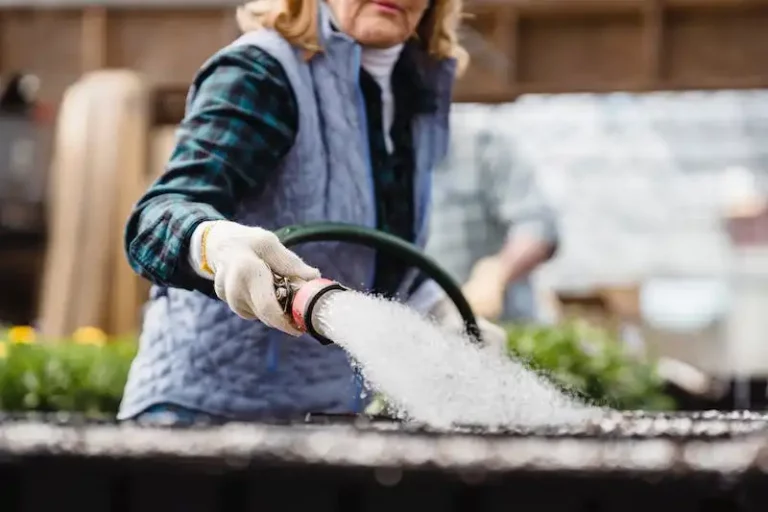The spider plant, scientifically known as Chlorophytum comosum, is a popular houseplant that is loved for its attractive appearance and easy care. It is a low-maintenance plant that is perfect for beginners or busy people who may not have a lot of time to devote to plant care. The spider plant is known for its long, arching leaves that can reach lengths of up to two feet. Its leaves are typically green, but some varieties have white or yellow stripes.
To keep your spider plant healthy, it’s important to provide it with the right conditions. Spider plants prefer bright, indirect sunlight, although they can tolerate some direct sunlight as well. It’s best to place your spider plant in a location where it can receive a few hours of morning or late afternoon sunlight. Make sure to choose a well-draining potting soil and a pot with drainage holes to prevent water build-up and root rot.
When it comes to watering, spider plants only need to be watered when the top inch of soil feels dry to the touch. Overwatering can lead to root rot and other problems, so it’s important to let the soil dry out between waterings. During the winter months, you can reduce the frequency of waterings since the plant is in its dormant period.
Spider plants are hard to kill and are generally resistant to pests and diseases. However, they can occasionally be affected by common houseplant pests like mealybugs, spider mites, and aphids. If you notice any pests on your spider plant, it’s important to identify them and take action to remove them. There are many natural and chemical methods available to control and eliminate pests, so make sure to choose the method that best suits your preference.
Spider plants are also known for their ability to produce offshoots, or baby spider plants, that can be propagated to create new plants. To propagate a spider plant, simply cut off one of the offshoots and place it in a glass of water or well-draining potting soil. Keep the soil moist and within a few weeks, the offshoot will start growing roots. Once it’s rooted, you can plant it in its own pot and watch it grow into a beautiful spider plant.
In conclusion, taking care of a spider plant is easy and rewarding. By providing it with the right conditions such as indirect sunlight, well-draining soil, and proper watering, you can ensure that your spider plant stays healthy and beautiful. With its attractive foliage, adaptability, and low-maintenance qualities, the spider plant is a great addition to any home or office. So why not give it a try and bring some greenery into your life?
How to Grow and Care for a Spider Plant Our Favorite Low-Maintenance Hard-to-Kill Houseplant
Spider plants (Chlorophytum) are one of the most popular indoor houseplants due to their low-maintenance and hard-to-kill nature. Whether you are an experienced gardener or a beginner, spider plants are a great addition to any home or office.
Spider plants are known for their arching leaves and cascading foliage, making them a beautiful addition to any space. They can tolerate a wide range of light conditions, but they prefer bright, indirect light. Placed near a window or slightly away from direct sunlight, spider plants will thrive.
To care for a spider plant, it is important to water it thoroughly and make sure the soil drains well. Over-watering can lead to root rot, so it’s best to let the soil dry out slightly between waterings. In the summer months, spider plants may require more frequent watering, while in the winter, they can go longer periods without water.
Spider plants are relatively pest-free, but sometimes problems like spider mites or scale insects can occur. If you notice any pests, you can gently wipe the leaves with a damp cloth or use an insecticidal soap to get rid of them.
When it comes to fertilization, spider plants don’t require a lot of extra nutrients. Fertilize them only once or twice a year with a balanced liquid fertilizer diluted to half-strength. Avoid over-fertilizing as it can lead to browning and tip burn on the leaves.
Spider plants are also known for their air-purifying qualities. They can remove toxins such as formaldehyde and carbon monoxide from the air, making them a healthy choice for indoor environments.
If your spider plant starts to take up too much space, you can easily prune it back. Simply cut the leaves or stems at the desired length with a pair of clean scissors or pruning shears. This will encourage new growth and keep your plant looking neat and tidy.
Spider plants are adaptable and can grow in a variety of conditions. They can be easily propagated by placing the plantlets in water or directly in soil. The new plantlets will grow roots and eventually develop into full-grown spider plants.
So if you are looking for a low-maintenance, hard-to-kill houseplant, spider plants are a great choice. Their adaptability and air-purifying abilities make them a happy addition to any home or office. Start growing your own spider plant today and enjoy the benefits it brings!
How to Grow a Spider Plant from Seed
If you have a spider plant and want to expand your collection, growing a spider plant from seed is a great way to do it. Spider plants are easy to care for, and they can thrive in a variety of conditions. By following this method, you can successfully grow your spider plant from seed.
First, collect the seed pods from a mature spider plant. Spider plants produce small white flowers that eventually turn into seed pods. These pods contain tiny black seeds. You can harvest the pods when they are brown and starting to split.
Next, prepare the soil for planting. Spider plants grow well in a well-draining soil mix. You can use a commercial potting mix or make your own by combining equal parts of peat moss, compost, and perlite.
Fill a small pot or seed tray with the soil mix. Make sure the pot has drainage holes to prevent waterlogging. Moisten the soil before sowing the seeds.
Sow the spider plant seeds on the soil surface, spacing them about 1 inch apart. Press them lightly into the soil and cover them with a thin layer of soil mix.
Place the pot or seed tray in a warm and bright location. Spider plants prefer temperatures between 65 and 75 degrees Fahrenheit (18-24 degrees Celsius). Keep the soil moist but not waterlogged. Covering the pot with a clear plastic bag can help retain moisture.
The germination process typically takes about 2 to 4 weeks. During this time, it’s important to keep the soil consistently moist and provide adequate light for the seeds to germinate.
Once the spider plant seedlings have developed their first true leaves, you can transplant them into individual pots or a larger container. Choose a spot with bright but indirect light, away from direct sunlight.
Spider plants are known for their air-purifying properties, so they make great indoor plants. They can tolerate a range of light conditions, from low light to bright indirect light. Keep them away from direct sunlight, as it can scorch their leaves.
Spider plants are also forgiving when it comes to watering. They prefer to be semi-potbound, so avoid overwatering. Water the plant when the top inch of the soil feels dry to the touch.
Spider plants are native to tropical regions of Africa and grow well in zones 9 to 11. However, they can be grown as houseplants in other zones, as long as the temperature is kept above 50 degrees Fahrenheit (10 degrees Celsius).
Spider plants produce long, arching leaves that can grow up to 3 feet in length. These leaves are often variegated with green and white stripes, giving the plant an amazing appearance. Spider plants also produce tiny white flowers that eventually become baby spider plants, which can be easily propagated.
In conclusion, growing a spider plant from seed is a rewarding and relatively easy process. By following the steps outlined above, you can enjoy the beauty of this graceful plant in your home or garden. If you have any questions or need advice on spider plant care, feel free to share them in the comments below. Happy gardening!
How to Care for a Spider Plant
The spider plant, also known by its botanical name Chlorophytum comosum, is a popular houseplant that can be kept anywhere–from warm, low-light areas to bright, sunny windowsills. Known for its arching, pale green leaves with white stripes, the spider plant adds a quick and easy statement to any home.
To keep your spider plant healthy and thriving, follow these tips:
| Temperature | Spider plants prefer temperatures between 55-80°F (13-27°C) |
| Light | They do best in bright, indirect light, but can tolerate some shade |
| Watering | Water your spider plant when the top inch of soil feels dry. Be careful not to overwater as this can lead to root rot. |
| Fertilization | Feed your spider plant with a balanced, water-soluble fertilizer every 2-4 weeks during the growing season (March to September). Reduce fertilization during the winter months. |
| Soil | Use well-draining potting soil to prevent water build-up and root rot. |
| Pruning | Trim any brown or yellow leaves, as well as offshoots that go beyond the desired shape. This will help maintain the plant’s overall appearance. |
| Propagation | Spider plants produce tiny white flowers, which eventually give way to baby plants or “spiderettes”. These can be grown into new plants by placing them in water until they develop roots, or by planting them directly in soil. |
| Pests | Spider plants are relatively pest-free, but they can occasionally attract pests like aphids or mealybugs. Regularly check the leaves for any signs of pests, and treat them accordingly. |
| Variegation | Variegated spider plants have white stripes on their leaves. To maintain the variegation, keep the plant in bright, indirect light and avoid direct sun exposure. |
| Semi-potbound | Spider plants do well when slightly root-bound. If your plant has outgrown its current pot, you can repot it into a slightly larger container. |
With these care tips, your spider plant will stay healthy and continue to bring a touch of green into your home.
Water
Proper watering is crucial for the health and well-being of a spider plant. Watering should be done regularly, but not excessively. The ideal temperature for watering a spider plant is around 60-75 degrees Fahrenheit (15-24 degrees Celsius).
Here are some tips for watering a spider plant:
- Water the plant when the top inch of soil feels dry to the touch.
- Use room temperature water to avoid shocking the plant.
- Spider plants are great air purifiers and thrive in most indoor conditions, so any type of watering can be beneficial for them.
- The best way to water a spider plant is by placing it under a tap and allowing the water to flow through the pot until it drains out from the bottom.
- Spider plants generally prefer to be slightly potbound, so make sure to choose a pot that is not too big.
- If the spider plant is kept hanging, make sure to bring it down to water and let it drain properly before hanging it back up.
- A well-watered spider plant has the potential to produce large numbers of spiderettes, which are tiny plants that develop at the base of the main plant.
- If the tips of the spider plant’s leaves are browning, it could be a sign of under-watering or low humidity levels.
- Spider plants are easy to propagate, so if you have a healthy plant, you can easily grow more by planting the spiderettes in their own pots.
- In addition to watering, spider plants benefit from regular leaf cleaning. Remove any dust or dirt from the leaves to keep them happy and thriving.
Spider plants can be grown indoors or outdoors, but they prefer bright, indirect sunlight. Avoid exposing them to direct sunlight as it can cause leaf burn.
Watering is an essential part of spider plant care, and following these tips will help ensure that your spider plant remains healthy and happy.




